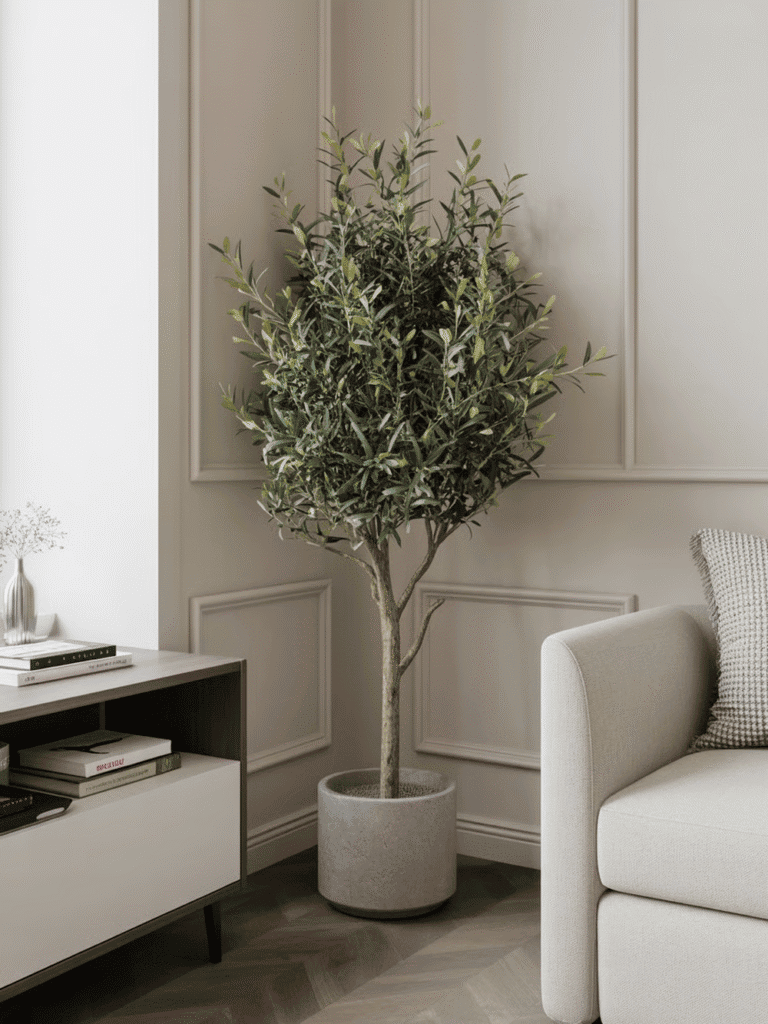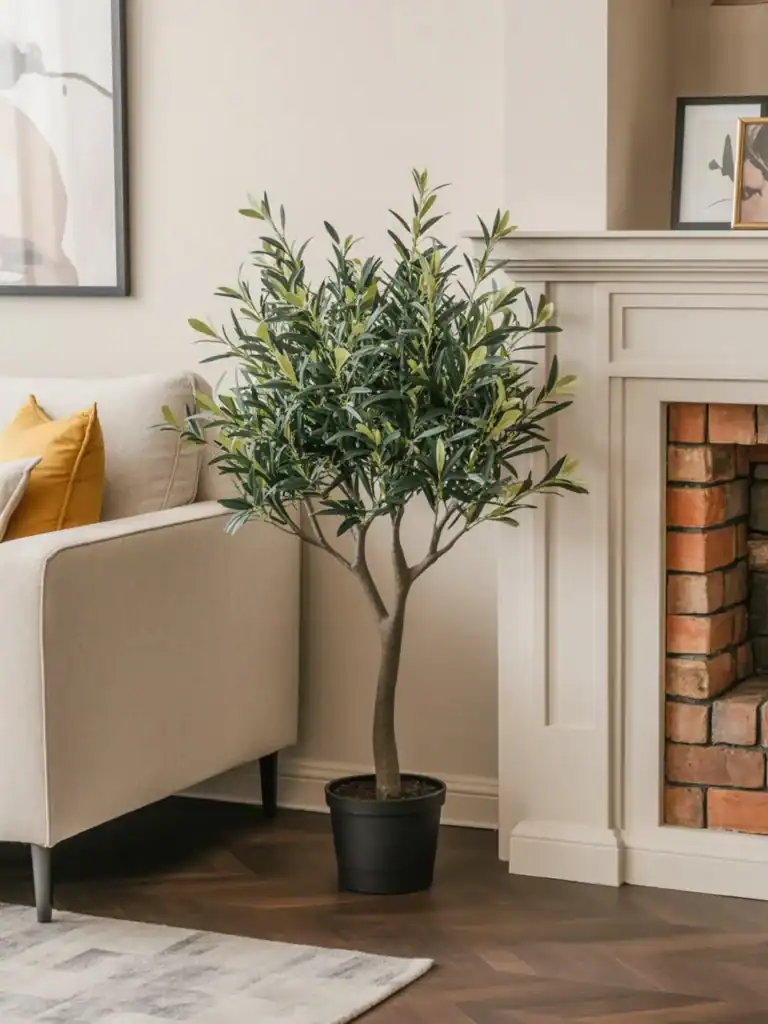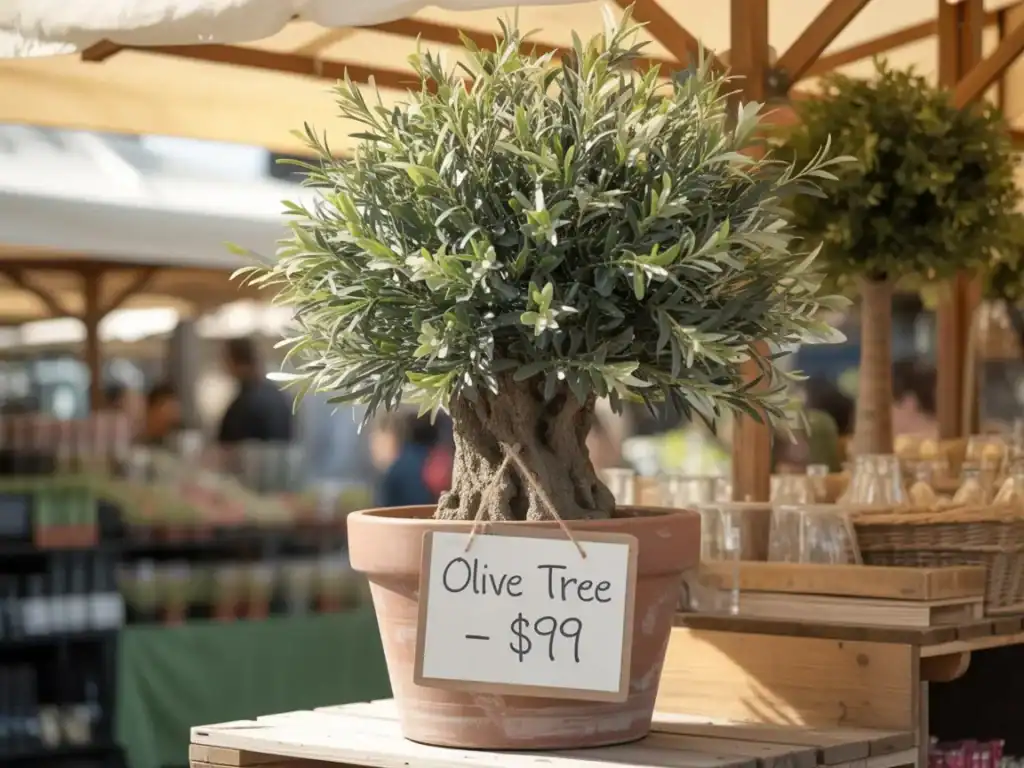Fake Olive Trees 101: Everything You Should Know
Olive Knowledge is a part of Amazon Associates. As an Amazon Associate, we earn from qualifying purchases. Read our Affiliate Disclosure to learn more.
If you ever thought of buying a fake olive tree for your home, there are some things that you should know prior to going and ordering one immediately.
In this post, I’ll show you everything you should know about faux olive trees, so you can be 100% prepared for the buy, and we’re sure you’re getting the most out of it.
There are good faux olive trees, and there are bad ones. Through this post, you’ll learn the differences.
What’s The Purpose of Faux Olive Trees?

People like to use fake olive trees for many reasons. They’re a fantastic home decoration, but can also be a great option to add some life to an office or other sterile environment.
The main purpose of olive trees is to make them completely independent of any type of care. Fake olive trees don’t require watering, repotting, fertilizing, or any other type of care that real trees do require.
Faux olive trees aren’t messy at all, which is also a reason why people decide to use them instead of real olive trees. If you like how olive trees improve the design of any spac,e but don’t have the time to take care of real olive trees, faux olive trees are probably the best choice.
How Do Fake Olive Trees Look?

When it comes to the look of faux olive trees, they come in many different shapes and sizes, but also in different build qualities. Some fake olive trees will look extremely realistic, while others may look flimsy and cheap. As always, both of them have their own customers, and both can improve the design of your home a lot.
The great thing about fake olive trees is that there are plenty of models and sizes that you can choose from. You can get large, small, fruitless trees with more or less vivid leaf colors, LEDs, etc.
You’re probably wondering if faux olive trees will look like real trees or if they all look flimsy. Well, there’s only one answer to that question – the price. You get what you paid for. More expensive trees will usually look better and will be closer to the original, while those cheap ones will look cheap.
You can always make some improvements to fake olive trees. Here’s an article that shows you a few improvements you can make to fake olive trees.
How Much Do Artificial Olive Trees Cost?

Many factors affect the price of artificial olive trees. Mostly, it’s the build quality and how close to the real olive tree it looks. As I already told you, the better it looks, the more expensive it’ll be (usually).
Fake olive trees can cost anywhere between $15 and $2,000. Mostly, extremely cheap ones will be tiny and look like olive tree branches, while the most expensive ones will mimic the look of a real tree.
From my research and experience, you should spend at least $70-200 for a nice-looking artificial olive tree if you want it to look nice. If you want a 100% realistic fake olive tree, prepare a bunch of money.
As you can see, the price of faux olive trees can vary a lot depending on your needs. The best thing you can do is to set a budget and then find the best tree that fits both your needs and your budget.
Is It Worth Buying Cheap Fake Olive Trees?
Cheap fake olive trees are a great way to add some life to your home or office, but they may not be the best option if you’re looking for something that looks realistic. Most of the time, cheaper trees will look more like branches than full-fledged trees.
However, if you’re not too concerned about the level of realism and just want something that looks good, cheap fake olive trees can be a great option. Just don’t expect them to look like the real thing.
So, with good market research, you’ll surely be able to find some cheaper artificial olive tree that still looks good and improves the design of your home, office, or any other place where you want them.
Where To Place Them?
People put fake olive trees in similar locations where they’d put the real ones. However, there’s no point in putting a fake olive tree somewhere outside, even though it’s also possible, and there won’t be any problems with high-quality fake olive trees.
Some of the most common places people like to place fake olive trees are:
- Living rooms
- Offices
- Anterooms
- Study rooms
Of course, you’re not limited to those locations. Let your imagination run wild. If it fits for you, everyone’s happy.
Best Places To Buy Fake Olive Trees

Usually, the best place to buy fake olive trees is somewhere where you can go physically and choose the one you like the most. However, most of us don’t have those shops near our homes.
So, in my opinion, the best place to buy fake olive trees is Amazon. There are plenty of choices, and more importantly, many people leave reviews over there, so you can get a better picture of quality, durability, and all other important factors that may determine whether you want to buy a specific artificial tree or not.
Below are a few of my top picks for fake olive trees, so make sure to check them out.
I hope that you’ll find some trees for your needs and that you’ll be able to improve the design of your home. By using fake olive trees, you won’t make a mistake. Just make sure not to buy the cheapest one out there.
Benefits Of Fake Olive Trees
In the end, I’d like to summarize and quickly show you a few benefits of artificial olive trees:
- Faux olive trees don’t require any maintenance
- They’re not heavy
- It’s easy to carry them around if you want to change the location
- Many of them can be edited (adding a few branches, etc.)
- You can spray them with some fragrance
- They’re long-lasting (unless you buy some cheap crap)
FAQs on Fake Olive Trees
Do fake olive trees look real in person?
High-quality artificial olive trees look very realistic, especially those with textured trunks and varied leaf colors. Cheaper models often look flat or plastic-like under light.
How can I make a fake olive tree look more realistic?
You can re-pot it into a heavier ceramic planter, add real soil or decorative moss on top, and gently bend the branches for a natural shape. A light dusting or fragrance spray also helps.
Are fake olive trees safe to use outdoors?
Most are meant for indoor use. If you plan to use one outside, look for UV-resistant and weather-proof models or place it in a covered area to prevent fading and brittleness.
How long do faux olive trees last?
Indoor models can last for years if kept clean and out of direct sunlight. Outdoor exposure shortens their lifespan due to UV damage.
How do you clean a fake olive tree?
Use a feather duster or microfiber cloth regularly. For deeper cleaning, wipe leaves with a damp cloth or mild soap solution. Avoid harsh chemicals that may discolor the leaves.
Do they come assembled?
Most artificial olive trees arrive partially assembled. You usually need to attach the top section or shape the branches after unboxing.
What size should I get for my space?
Small trees (2–4 ft) fit well on tables or in corners. Medium ones (5–6 ft) suit living rooms or offices. Large ones (7 ft +) make great statement pieces near entryways or empty walls.
Do fake olive trees fade over time?
Yes, especially cheaper ones or those exposed to sunlight. UV-protected models last much longer and maintain color better.
Can I change the pot it comes with?
Yes. Many buyers re-pot their fake trees into decorative planters for stability and a more natural look. You can secure the base with stones or foam.
Are fake olive trees worth the money?
If you want the look without maintenance, yes. They require a one-time purchase, no watering, and stay green year-round — making them cost-effective in the long run.



